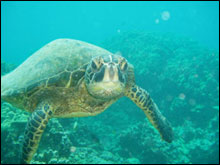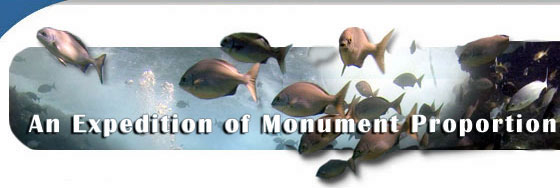|
Mission Log: July 19, 2006
Hawaiian Green Sea Turtles
Patricia Greene
NOAA Teacher-at-Sea
Unlike the spinner dolphins, we have observed the Hawaiian green sea turtles tend to be rather shy and elusive. We managed to catch just glimpses of them from a distance. Based on past slaughters by man it is no wonder these creatures would avoid contact with humans. Historically, from the late 1800’s until 1970’s these creatures were slaughtered and harvested. Finally, in 1978 turtles were recognized under the U.S. Endangered Species Act however, they are still harvested in many parts of the world.
 |
| A large green sea turtle basking in the sand. (Photo: Patricia Greene) |
Our luck changed on Southeast Island at Pearl and Hermes Atoll in the Hawaiian Islands National Wildlife Refuge. While circumnavigating the island we viewed a large adult green sea turtle pulled out and basking on the beach. After lunch we viewed from a distance two more green sea turtles basking and swimming in the surf. Researchers told us that they often observe 10 to 20 turtles pulling out at sunset and sleeping on the beach at night. It is more common in the Northwestern Hawaiian Islands than the main Hawaiian Islands for green sea turtles to exhibit this basking behavior. It is thought the behavior may be an adaptation to the cooler waters (i.e., a mechanism of thermoregulation, or a predation avoidance strategy due to the high populations of tiger sharks).
Several adaptations make the green sea turtle well suited for life in the ocean. Special lachrymal glands in the eye assist in the regulation of salt in the turtle’s body, preventing it from becoming dehydrated. When sea turtles shed tears they are actually removing salt from their bodies. Sea turtles are capable of storing large amounts of oxygen in their blood and muscle tissue, and lungs are adapted for rapid exchange of oxygen. Green sea turtles can stay under water up to five hours. Modified forelimbs give the sea turtle an efficient forward power-stroke. Protective coloration in the form of counter shading and blending gives the sea turtles camouflage. The underneath of the shell is cream color so the turtle blends with the sky and water to anything looking up and has a dark top shell for any predator looking down.
Green Sea turtles reach sexual maturity at approximately 25 to 30 years and reach a weight in excess of 200 lbs. Green sea turtle’s breeding behaviors demonstrate great stamina. Pairs may remain coupled for 10 to 12 hours and both sexes have multiple partners throughout the mating season. Adult males can be distinguished from females by their longer tails and curved claws on their flippers.
 |
| Three endangered Hawaiian green sea turtles bask on Southeast Island in the Hawaiian Islands National Wildlife Refuge. (Photo: Paulo Maurin) |
Green sea turtles are oviparous (lay eggs externally) in a sand pit on the beach. Nesting starts in May and continues through August. Critical components of the nest site must include: lack of predators, a moist substrate, and suitable temperatures and be located beyond the high tide mark. Typically the green sea turtle will lay 75 to 150 eggs at night, in a clutch and lay multiple clutches during the breeding season. Incubation takes 50 to 70 days depending upon ambient temperatures. Sex of the hatchlings is not determined at the time of fertilization or conception (no sex chromosomes) but dependent upon the temperature of the sand and individual position of the egg in the nest. This is called “TSD” or Temperature-Dependent Sex Determination. The pivotal temperature for the green sea turtle is 28.26 degrees Celsius (82.9 degrees Farenheit). This is the temperature at which equal number of male and female hatchlings will be produced. If the temperature falls below this number more males will be produced; above more females will be hatched.
After the hatchling breaks out of the shell it must then reach the surface. Hatchlings demonstrate “protocooperation” meaning they work together as a group for several days in a joint effort to reach the surface. The hatchlings take turns digging and resting. Once they are near the surface the heat of the day will immobilize them and they will not continue their escape until the evening temperatures have cooled the sand. In this way they avoid heat stress and predators.
Now the hatchlings must find their way to ocean, avoiding the ghost crabs of the night. It is thought they employ a variety of visual clues, “wave compass” and perhaps a “magnetic compass” in their effort to reach the ocean. Scientists believe the wave compass allows the hatchlings to get orientated directly against the incoming waves. The magnetic compass refers to the magnetite found within their brains that may align them with earth’s magnetic fields. Once they arrive at sea, they will dog paddle to open water; hiding in algae, drift lines or other floating debris.
During this pelagic stage they are carnivores and feed on plankton. They will remain at sea in this hatchling/early juvenile stage for years, sleeping with their flippers folded over their back to diminish their chance of becoming a morsel for some predator. This stage is a period of rapid growth; perhaps 8 to 10 cm the first year. The young turtles will re-appear in coastal waters where they will continue to grow, graze on algae and become life-long herbivores. The green sea turtle has specialized microorganisms in the hind gut that digest the cellulose in the plant material. It is possible that juveniles establish this flora by practicing “scatophagy” or the ingestion of adult turtle feces.
 |
| A curious Hawaiian green sea turtle approaches underwater at Puako in the main Hawaiian Islands. (Photo: Claire Johnson/NOAA) |
Typically sea turtles thrive on sea grasses, seaweeds and algae. Depending upon where they live their diets may vary; for example green turtles of the Pacific Ocean are more dependent upon algae and seaweeds than the sea turtles of the Atlantic Ocean that thrive on the sea grasses such as turtle grass. The diet of the green sea turtles at Kure Atoll consist of an algae called Codium edule. In the main Hawaiian Islands invasive alien species of algae in the marine ecosystems have displaced the native species of algae that the turtles have traditionally fed on. This has caused widespread damage to the coral reef habitats.
Another concern for the green sea turtle population has been the appearance of fibropapilloma tumors. Tumors on the eyes, throat, lungs, kidneys, liver and intestines have been documented. Scientists believe a Herpes-type virus may be responsible. The disease is quite common in the mainland Hawaiian Islands but relatively rare in the Northwestern Hawaiian Islands. These tumors may blind the turtle or choke them depending on the location of the tumor. Fortunately, we did not observe any tumors while we have been in the Northwestern Hawaiian Islands.
The Northwestern Hawaiian Islands are extremely important to the green sea turtles. It is one of the last places where turtles are not affected by man’s desire for beach front property; no issues of coastal development, domesticated predators, recreational activities, artificial lights, high speed boat traffic, or general coastal degradation of the habitat. Over 90% of Hawaii’s green sea turtles return to nest at the French Frigate Shoals. Turtles come from the far north end of the Northwestern Hawaiian Islands chain (Kure, Pearl and Hermes, Midway Atolls) and from outreaches of the main Hawaiian Islands to lay their eggs at French Frigate Shoals.
Special thanks to the Hawaiian Islands National Wildlife Refuge, United State Fish and Wildlife Service, Department of Interior for access to Southeast Island and an opportunity to spend a day with the NOAA Fisheries biologists to learn more about the spinner dolphin research they conduct during their field season.
References
Gulko, David and Karen Eckert. 2004. Sea Turtles: An Ecological Guide. Mutual Publishing.
Gulko, David. 1998. Hawaiian Coral Reef Ecology. Mutual Publishing.
Rauzon, Mark K. 2001. Isle of Refuge: Wildlife and History of the Northwestern Hawaiian Islands. University of Hawai`i Press.
|



